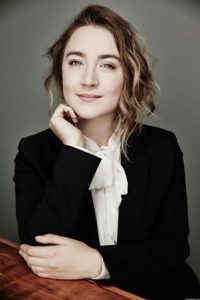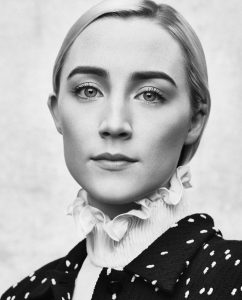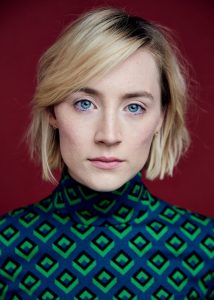
Saoirse Ronan is describing the aftermath of her first acting job. “I went into this melancholic state for a few weeks,” she tells me. “I remember sitting on the bed with Mam next to me, and I was like: ‘I’m never going to have that experience again.’ ” The community that had come together on set and developed real bonds had now permanently dispersed. “It was that thought: That exact crew will never work together again. Never.” The project was an Irish television drama called The Clinic. When she appeared on it, Ronan was nine years old.
Now 24, Ronan has returned to live in her native Ireland.
“Ireland is smaller than England, and I love it for that. I missed this,” she says, gesturing at the water and the sweep of coastline. Though she also lived in Dublin for a time, she grew up mainly in County Carlow, in southeastern Ireland, surrounded by countryside.
“That never leaves you,” she says as we walk toward the seafront. “I feel most at home and at peace when I’m in the country. Though I like being in London too,” she adds. “There’s an anonymity. You can disappear into the human flow.”
 Not so here. A passerby stops us and asks Ronan for a photograph. She obliges, smiling, and the stranger thanks her. For a moment I’m a little surprised that Ronan has been recognized: Her face is largely hidden by a pair of mirrored sunglasses, and she seems much smaller than she appears in her films. I volunteer to take the photo, and on the phone’s screen—framed against the saturated blue of sky—she looks more like herself, or more like the version of her I know.
Not so here. A passerby stops us and asks Ronan for a photograph. She obliges, smiling, and the stranger thanks her. For a moment I’m a little surprised that Ronan has been recognized: Her face is largely hidden by a pair of mirrored sunglasses, and she seems much smaller than she appears in her films. I volunteer to take the photo, and on the phone’s screen—framed against the saturated blue of sky—she looks more like herself, or more like the version of her I know.
When we sit down, on a stone bench overlooking the coast, she confesses how strange she finds these experiences: “I still get completely shocked that anyone knows who I am.” I ask if she would prefer to do what she does without having to be famous. “Yeah, I would,” she replies. “But I’m not . . . famous.” I probe a little and, to clarify, she responds, “I just genuinely don’t think I am.” She pauses. “Selena Gomez is famous.”
Behind us, families with small dogs make their way to and from the town center, and before us, yachts bob and settle in the waves. If Ronan really is impervious to her own celebrity, it might be because she doesn’t monitor her own press coverage. “If you’re not aware of how often you’re in a newspaper, then it’s like it’s not really happening,” she says. In her limited free time, she prefers to cook, hear live music, or go to the movies. (Tully was a truly “brave film,” she tells me; “anything Luca Guadagnino makes, I fall in love with.”) I find it hard to believe that anyone, especially at the age of 24, could be so uninterested in her own public image. Isn’t she curious? “I just get so anxious whenever I watch anything that I’m in,” she tells me. I ask what kind of anxiety she means. “I’m fine with the way I look now,” she responds carefully. “But I wouldn’t necessarily be looking at photographs of myself all day. I don’t want to become too consumed by the image of myself.”
Ronan earned her first Oscar nomination at age thirteen, for a disconcertingly intelligent performance in Joe Wright’s adaptation of Ian McEwan’s Atonement. In 2015 she was the heart of John Crowley’s Brooklyn, based on the novel by Colm Tóibín, and she won a Golden Globe this year in the title role of Greta Gerwig’s Lady Bird. Though she did not take home an Oscar for that performance, her pale pink ankle-length sheath by Calvin Klein was a hit. (Along with Lupita Nyong’o, Ronan is one of the faces of Raf Simons’s first fragrance for the house, Women.)
More recently, she’s played a young bride in Dominic Cooke’s On Chesil Beach(another McEwan adaptation) and Nina in Michael Mayer’s screen version of The Seagull. Though she’s constructed an impressive career without a superhero franchise perpetually screening at the multiplex, she isn’t utterly opposed to such a role. “I mean, I haven’t been offered any!” she says, laughing. “If a script came along that was strong, interesting, original, I would take it. A good script is a good script.” Her next film is one such: She plays Mary, Queen of Scots, in Josie Rourke’s biopic of the sixteenth-century monarch, out this December.
Gradually the wind grows cold and clouds draw a white film over the horizon. Ronan suggests we walk back to her place for tea. On the way, she tells me how protective she’s become toward young people in her industry—people like “Timmy,” the actor Timothée Chalamet, the star of Guadagnino’s Call Me by Your Name, who also appeared in Lady Bird and is roughly one year her junior. I point out that Ronan herself is still young. “I know,” she says, catching herself. “I’ll talk about other people like that.” It’s not just that she sees herself as an industry veteran. “I’ve never felt young,” she tells me. At thirteen, she worked alongside the actor Guy Pearce on a movie called Death Defying Acts; when they were reunited on Mary Queen of Scots he told her, “You’re the same as you were when you were thirteen.” Other colleagues and friends agree. Margot Robbie, who plays Elizabeth I in Mary Queen of Scots, describes her as “beyond her years”; Tóibín tells me she is “very, very sensible—she’s got an old head, an old soul.”
 As we reach the house, set back from a quiet residential street by a sweeping driveway, her dog, Fran, springs forward to greet us. Ronan introduces me to the Westie-retriever mix as if to a charming friend. “Will you give Sally the paw?” she asks. Fran presents me with her paw. “She’s a genius,” Ronan says admiringly, “an absolute genius.”
As we reach the house, set back from a quiet residential street by a sweeping driveway, her dog, Fran, springs forward to greet us. Ronan introduces me to the Westie-retriever mix as if to a charming friend. “Will you give Sally the paw?” she asks. Fran presents me with her paw. “She’s a genius,” Ronan says admiringly, “an absolute genius.”
While her mother, Monica, kindly brings us tea and biscuits, Ronan tells me about her early career. Her father, Paul, an actor with experience in both TV and film, had noticed that his daughter loved being on camera and started to put her forward for roles. With the success of Atonement, Ronan left school and began to juggle home tutoring with an intense work schedule.
Throughout Ronan’s teens, her parents—most often her mother—accompanied her to work. Though she speaks of the film industry with love and insists she has never been the victim of exploitation, she can still remember uncomfortable experiences. A director once pushed a particularly sensitive scene, taking advantage of Ronan’s youth and willingness to please. “My mam walked onto the set,” she tells me. “She said, ‘You’re not doing that again unless we map out exactly when this is going to stop.’ I was very lucky that I had a proper protector with me.”
Ronan’s parents have been more to her than just protectors, however. Homeschooling and travel meant that the actress never formed a steady peer group, as most teenagers do; in some ways, she relied on her family to fill that gap. Today her deep affection for her mother is evident not only in the way she speaks of her—as a trusted guardian—but also in how difficult she found it to acclimate to filming without Monica by her side.
“When I started working on my own, I didn’t have that person I could turn to and go, ‘Did they like that?’ I didn’t have that safety blanket anymore.”
Ronan generally speaks of her job less as a career than as a calling. “It’s very intimate,” she says. “There are certain moments where it feels like it’s just you and the lens.” This almost private experience is connected to the years she’s spent performing: “It’s something that has been a very stable, consistent thing in my life. The camera has been the thing that has stuck around the longest.” Tóibín, who struck up a friendship with Ronan during the making of Brooklyn, points out that in her youth, “when everyone else was going to dances around Carlow, Saoirse was working.” Asked whether she ever feels sad or frustrated that she didn’t get a chance at a normal young adulthood, she says, “Of course when you’re a teenager you want to belong to something. For me that was being on a film set, so I worked a lot.”
Listening to Ronan speak, I’m reminded of what Tóibín says about the dynamic brilliance of her technique: “She’s always working out, ‘Is there a nuance, is there a way I can now do the opposite of what I’ve just been doing?’ ” Acting, she tells me, is partly about striving to counteract her own assumptions: “You need to push yourself out of that bubble of intuition and find a different way of being honest.” On the process of making Lady Bird with Ronan, Gerwig says, “We talked and rehearsed and collaborated, and the final film belongs to her as much as to me.” Ronan credits Gerwig with encouraging her to pursue her ambition of directing. Laurie Metcalf, who played Ronan’s mother in Lady Bird, tells me that she thinks Ronan “would be extremely comfortable behind a camera. She’s got a great eye.”
After an intense run on Broadway two years ago in Ivo van Hove’s production of The Crucible, Ronan would also like to find time for more theater; the idea of an Irish play is especially appealing. “Theater directors in particular really come in and shape something,” she says. Playing Abigail Williams opposite Ben Whishaw’s John Proctor in more than 150 performances, she developed a deeper understanding of Arthur Miller’s drama. “Doing it for that long, the play becomes this other beast for you,” she says. “I had gotten to know Abigail so well—she was mine every night.”
 As a child star, Ronan was not expected to divulge details about her private life, because children are not generally thought to have private lives. Now, she says, “I think people know not to ask me certain things. They’re not going to know who I’m going out with or where I live.
As a child star, Ronan was not expected to divulge details about her private life, because children are not generally thought to have private lives. Now, she says, “I think people know not to ask me certain things. They’re not going to know who I’m going out with or where I live.
They’re not going to know much about my family.” Her closest friendships appear to be with a childhood friend from Carlow named Scarlett Curtis, now a feminist writer and activist in her own right, and with Eileen O’Higgins, her costar in Brooklyn, whom she took as her date to the Golden Globes. But at times, Ronan’s work ends up taking precedence over her personal life. “When I’m working, I can’t really do anything else,” she says. “I can’t go out, I can’t meet up with anyone, I don’t read anything.” She smiles. “Someone said to me, ‘You’re monogamous when it comes to your work,’ and it’s so true,” she says. “You can only commit to one thing at a time.”
When a project finishes, it’s back to the “melancholic state” she first experienced when she was nine—grieving for another community of cast and crew. “You don’t ever fully get over that,” she tells me. “You just learn to cope with it.” And it takes time for a new project to replace the last. “At the very beginning of pretty much every job I think, I’m not going to be able to do it this time. I’ve forgotten how to do it.”
A week later, I meet Ronan in Dublin’s Hugh Lane Gallery, a public art collection in the city center. It’s an overcast afternoon, but inside the gallery it’s unexpectedly warm, and we quickly wriggle out of our jackets and cardigans. Ronan says she appreciates the visual arts, but she’s the type of patron who likes to take her time. “The art does take on a life, a little bit, the more you look at it.” As we make our way through the gallery, she stops in front of Maurice de Vlaminck’s Opium, a Cubist portrait of a seated woman with red-blonde hair smoking a pipe. “She looks a bit like Mary,” Ronan remarks. To inhabit the role of Mary Stuart, Ronan relied, as she often does, on an intuitive sense of connection between herself and the character. “There were so many comparisons that I could make,” she says. As both an actor and a queen, she points out, “you’ve got to be ‘on.’ ”
It was first announced back in 2012 that Ronan would play the lead in the biopic of the Scottish monarch, who returned from France as a teenager to rule the country of her birth. At a time when rival royal houses competed for the English throne, Mary represented a threat to the reign of her cousin Elizabeth I. Mary, a Catholic, was descended from the House of Stuart, while Elizabeth, a Protestant, represented the ruling House of Tudor. Five years after Ronan signed on, with theater director Josie Rourke set to direct and Margot Robbie to play Elizabeth, filming on Mary Queen of Scots finally commenced.
The artistic director of London’s Donmar Warehouse since 2012, Rourke came on board to direct her first feature principally because Ronan was involved. The two share an interest in Mary as a historical figure: Her famous beauty, her ingenuity, her sensational fate—she was betrayed, exiled from Scotland, and ultimately beheaded at Elizabeth’s decree—have long made her a focal point for historical narratives about femininity and leadership. The film finally came into being, Rourke suggests, because of Ronan. “So many of the people who did the film did it because they wanted to be in proximity to her, as an actor,” she says. “Even as an incredibly young woman, she has that power.”
 More intimate than a typical period drama, the movie becomes an unexpectedly intense, racking examination of Mary’s psychology: her impulsiveness, her defiance, the almost frightening hardness at her core. Though she endures great suffering, Ronan’s Mary seems somehow untouched by it; like a martyr, she only grows cooler, clearer, more certain. It’s a strangely convulsive movie—I felt myself trembling along with Mary as I watched. Both Ronan and Robbie tell me that they experienced the film’s final act, in which their characters meet for the first time, as a defining moment in their work.
More intimate than a typical period drama, the movie becomes an unexpectedly intense, racking examination of Mary’s psychology: her impulsiveness, her defiance, the almost frightening hardness at her core. Though she endures great suffering, Ronan’s Mary seems somehow untouched by it; like a martyr, she only grows cooler, clearer, more certain. It’s a strangely convulsive movie—I felt myself trembling along with Mary as I watched. Both Ronan and Robbie tell me that they experienced the film’s final act, in which their characters meet for the first time, as a defining moment in their work.
Its intensity made me start to understand Ronan’s focused, all-consuming approach to her career; her drive to shut everything else out; her restlessness when not working; her grief when a job finishes. I ask, as we reach the end of the gallery, whether she ever feels lucky to have a calling. She looks away briefly, and her face changes; for a moment I wonder if I have upset her. “Yeah,” she says. “You want to be doing something in your life that wakes you up.” She rubs at her nose.
“There’s something wonderful about doing the type of work that is a part of you,” she says, “because you can give it everything you’ve got. And it gives so much back to you as well. You become better. You become a better person.”
Story by Sally Rooney / Source: Vogue.com




















Leave a Comment